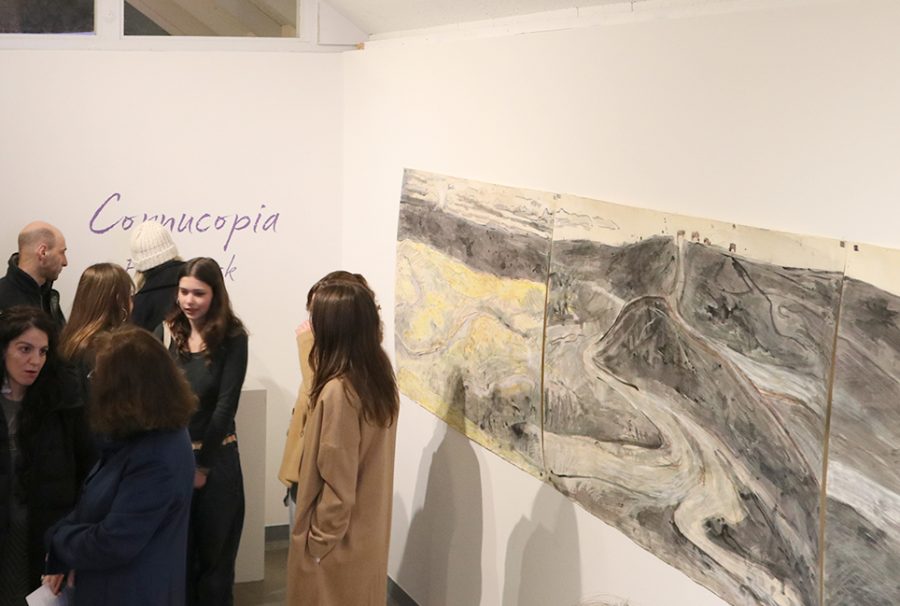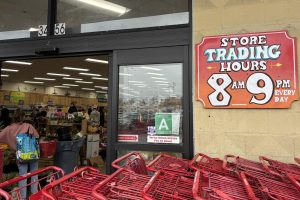Eastern Star Gallery’s second show, “Cornucopia,” inspires deep thought with anti-colonialist, environmentalist art
Photo credit: Allie Yang
People converse and view “They Come to Pay Respect: Boreal Forest As Tar Sands” at the opening exhibition of Cornucopia. The piece is a 12-foot by 3.5-foot monotype made by Paper Buck, which uses used oil pastel, India ink and tusche.
January 24, 2023
The Eastern Star Gallery showcased cyanotype, monotype, digital print and three oil paintings at its second show of the year: “Cornucopia.” The show opened Dec. 14 in the Eastern Star Gallery. The pieces, made by Paper Buck, will remain in the gallery until Feb. 3, 2023.
Paper Buck is a Philadelphia-based artist who, according to his artist statement, creates work that “attempts to destabilize the normalization of settler colonial ideologies within American politics, power structures and land interrelationships.” His most recent pieces examine the environment, its preservation and American settler narratives. Though he currently lives in his home city, Eastern Star Gallery Board member Sophie Altemus said his distance from Archer did not keep him from having a significant role in the show’s preparation process.
“He’s given us creative freedom to voice what we would like to be seen and what we would like to work with him on. He’s also had autonomy in deciding what pieces he wants to show,” Altemus said. “[There’s] been a lot of collaboration, working together and behind-the-scenes communicating.”
Gemma Wyles (’25), another member of the Eastern Star Gallery Board, said the appeal of Buck’s art lies in its ability to evoke contemplation and connection in the viewer.
“It’s the striking visual image that is laid out for you, [allowing] you to interpret a story,” Wyles said. “Whether it is very personal or it has a very large, abstract meaning, I always find a way to connect these to [the] pieces.”
Talya Petrillo is a visual arts teacher and a friend of Buck, who introduced his work to the Eastern Star Gallery Board. She said his pieces show evidence of meticulous dedication, which is why she finds beauty in his work.
“He’s always so intentional with his with each thing that he makes,” Petrillo said. “That’s why I really value him as an artist. Everything he considers to be a finished art object is something he has put such an intense and intentional amount of thought and research into.”
Buck appeared at the opening via Zoom to lead a virtual walkthrough of the gallery. According to Altemus, Buck uses art as a means of advocacy in the contemporary world. She said by doing so, Buck’s pieces connect to the universal purpose of art.
“[He combines] it with actual issues in the world and [uses] art as a form of expression and communication,” Altemus said. “Painting something you see … can be really powerful and beautiful, but art is a lot more than just beauty. It’s not about what the art looks like but it’s about why we create the art. He has a great why-factor to his art.”
“Cornucopia, Or, An Essay On American Scenery (After Wendy Red Star and Thomas Cole)” is a digital print displayed in the gallery, which used Photoshop to scrape and stack images together. Petrillo said this work expands beyond the print as it has a political and emotional impact.
“There’s something very affectionate about it and aggressive simultaneously. I love that tension in the process,” Petrillo said. “There’s something very satirical about it, and I appreciate the use of humor … in that one because it’s very punchy and overtly political.”
Buck identifies as a transgender man who attended an all-girls school. Because of this, Wyles said his work had more potential to resonate with Archer students.
“Having that eye of what it’s like to be in an all-girls school, everyone will be able to find some sort of connection in his piece,” Wyles said. “For some reason, a lot of the people that come out of all-girls schools have a very different eye in the world…It comes down to understanding things aren’t always what they seem and always wanting to challenge, interpret and find meaning.”
Ultimately, Altemus said she hoped Cornucopia would inspire people to expand their perspective on the impact of art while it remains in the gallery.
“I hope people see art can be a form of communication that transcends traditional language,” Altemus said. “It can be a way of speaking up about issues in a nonverbal way that can sometimes be even more powerful.”









